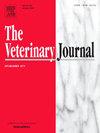用环介导的等温扩增技术监测合群啮齿动物的钩端螺旋体宿主。
IF 3.1
2区 农林科学
Q1 VETERINARY SCIENCES
引用次数: 0
摘要
钩端螺旋体病是一种由致病性钩端螺旋体引起的人畜共患疾病,由于其对农村和城市人口的影响,是一个主要的公共卫生问题。鼠类,特别是褐家鼠、家鼠和小家鼠是钩体的主要寄主,它们通过尿液排出钩体,对环境造成污染。在这项研究中,我们评估了环介导等温扩增(LAMP)的有效性,这是一种分子诊断工具,用于检测捕获的啮齿动物肾脏样本中的钩端螺旋体DNA。LAMP检测结果与标准的lipL32 PCR检测结果进行比较。9.0%(14/156)的标本检出钩端螺旋体DNA,其中LAMP和lipL32 PCR均阳性5.8%,LAMP单独检测阳性3.2%。无PCR阳性,LAMP阴性。Cohen’s Kappa指数(0.77)表明两种方法基本一致。LAMP的高灵敏度、检测致病性和中间型钩端螺旋体菌株的能力以及成本效益使其成为资源匮乏地区的一种有价值的工具。然而,该技术无法区分钩端螺旋体的种类,这突出表明流行病学研究需要补充方法。这些发现有助于了解啮齿动物钩端螺旋体病的宿主,并为兽医和公共卫生监测提供实用的诊断解决方案。本文章由计算机程序翻译,如有差异,请以英文原文为准。
Surveillance of leptospiral reservoirs in synanthropic rodents using loop-mediated isothermal amplification
Leptospirosis, a zoonotic disease caused by pathogenic Leptospira spp., represents a major public health concern due to its impact on both rural and urban populations. Rodents, particularly Rattus norvegicus, Rattus rattus, and Mus musculus, are key reservoirs, excreting leptospires in their urine and contributing to environmental contamination. In this study, we evaluated the efficacy of loop-mediated isothermal amplification (LAMP), a molecular diagnostic tool, for detecting leptospiral DNA in kidney samples from captured rodents. LAMP results were compared with the standard lipL32 PCR assay. Leptospiral DNA was detected in 9.0 % (14/156) of samples, with 5.8 % positive by both LAMP and lipL32 PCR and 3.2 % positive by LAMP alone. No samples were positive by PCR and negative by LAMP. Cohen's Kappa index (0.77) indicated substantial agreement between the two methods. The higher sensitivity of LAMP, its ability to detect both pathogenic and intermediate leptospiral strains, and its cost-effectiveness make it a valuable tool for low-resource settings. However, the technique’s inability to differentiate between Leptospira species highlights the need for complementary methods for epidemiological studies. These findings contribute to the understanding of rodent leptospirosis reservoirs and offer practical diagnostic solutions for veterinary and public health surveillance.
求助全文
通过发布文献求助,成功后即可免费获取论文全文。
去求助
来源期刊

Veterinary journal
农林科学-兽医学
CiteScore
4.10
自引率
4.50%
发文量
79
审稿时长
40 days
期刊介绍:
The Veterinary Journal (established 1875) publishes worldwide contributions on all aspects of veterinary science and its related subjects. It provides regular book reviews and a short communications section. The journal regularly commissions topical reviews and commentaries on features of major importance. Research areas include infectious diseases, applied biochemistry, parasitology, endocrinology, microbiology, immunology, pathology, pharmacology, physiology, molecular biology, immunogenetics, surgery, ophthalmology, dermatology and oncology.
 求助内容:
求助内容: 应助结果提醒方式:
应助结果提醒方式:


